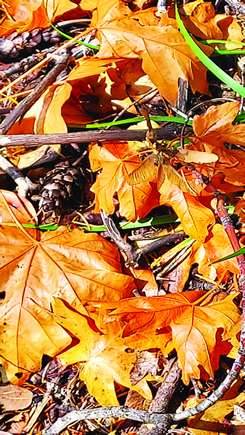How To: Build Fertility with
Leaves & Branches While it is always better to let leaf litter lie where it falls to protect the soil and insects in your ecosystem (see "Let Fallen Leaves Lie, Gardeners in Netherlands Town Urged" from The Guardian), sometimes that's just not possible. So, our advice is, when life gives you lots of leaves (and branches) use them to improve your soil! Over the years, farmers
and gardeners have noticed
that soil gains
in fertility when it
is covered up—even
by something that
has no nutrients, like
snow or plastic. Why?
Nobody knows! There
are factors in play we
don't understand. But
you don't have to understand
it to profit
from it. Any mulch will
give a slight increase
in fertility, reduce soil
compaction, reduce
soil loss from rain or wind, and reduce the number
of weeds. If you have nothing better, flattened cardboard
boxes will do all of the above and feed earthworms
as well. (We do not recommend plastic.) Of course, if the cover is a mulch of organic matter, the effect is much, much greater, because of all the nutrients released by the mulch and all the soil life that is drawn to it. Carbon in particular is food for many many micro-organisms, as well as larger life forms like earthworms that build fertility. Mulch starts an upward spiral, because the earthworms make tunnels—which brings oxygen deeper into the soil so that even more life can thrive and build even more fertility! So straw, lawn clippings, or leaves build richer soil, even in winter. Only recently have we realized how leaves and smaller branches feed the soil. Gibberellic acid, which sparks seed germination for many plants, is much, higher in forest soils where leaves, twigs, and fungi form the soil. Scientists have also learned that humus is formed more rapidly by mycelium—the underground network made by carbon-eating fungi— than by most composting methods. Leaves are high in the minerals—calcium, potassium, and magnesium— that build strong healthy plants. Instead of giving your plants a big boost of nitrogen that causes fertility to spike and then fall, they give your soil well-balanced and long-lasting richness. If you have access to leaves, there is no better mulch to prevent weeds, feed earthworms, and build fertility. Harness the carbon in ramial wood. Research in Canada has shown that chipped branches and twigs—called ramial wood—has many more nutrients than the wood from tree trunks that we use for construction, firewood, and so on. Far from being "waste", this ramial provides food for the fungi and bacteria that make rich soil. It is also a great, easyto- use weed-smothering mulch. Applied in winter, a ramial mulch is colonized by beneficial fungi during the winter and can be incorporated with the top 3 inches of soil to make a fertile seedbed come spring. Most houses have some area that is too narrow, too public, too ugly, or too shady to be a prime garden spot. Make it a fertility farm instead. Screen unsightly views and harvest free fertilizer at the same time. Fast-growing deciduous trees not only fill the space with beauty and bird life instead of problems—they can also be a source of fertilizer that increases for decades. If you choose species like empress tree, locust, and alder that can be cut back and regrow from the roots, you have a source of garden posts and trellis as well. Trees bring minerals from deep in the soil, and then conveniently drop those minerals on your yard. Sources: Many people are able to mulch their whole garden just by taking what their neighbors leave at the curb yard waste. Other people are able to benefit from municipal programs that convert "yard waste" into compost or mulch. If you have any trees or shrubs that are shedding leaves, you can leave them where they fall on perennial beds, use them to mulch on vegetable beds, or mix them in compost along with fluffier ingredients. Some people, remembering about gibberellic acid and seed germination, make a special compost high in leaves to use for seed-starting. Since ramial branches are the very part that most tree services, county road crews, and telephone companies are wanting to get rid of, there is a vast amount available, often for free. Just ask your city, county, telephone company, and private tree services if they have excess wood chips. Some will come and dump them on your driveway. ♥ top | Newsletter Home |Table of Contents| Archive
|



